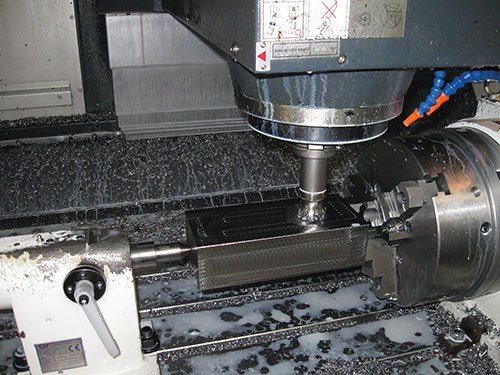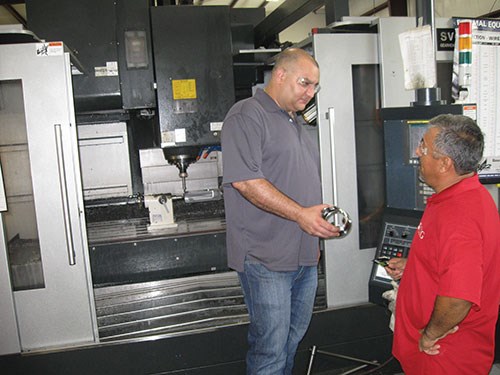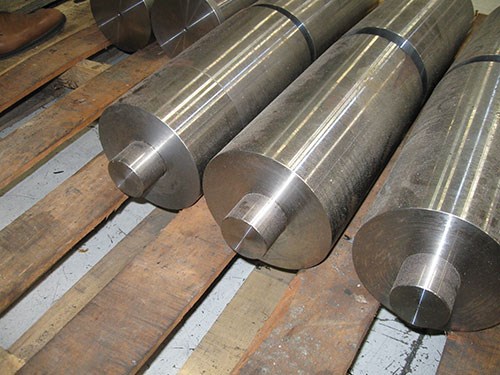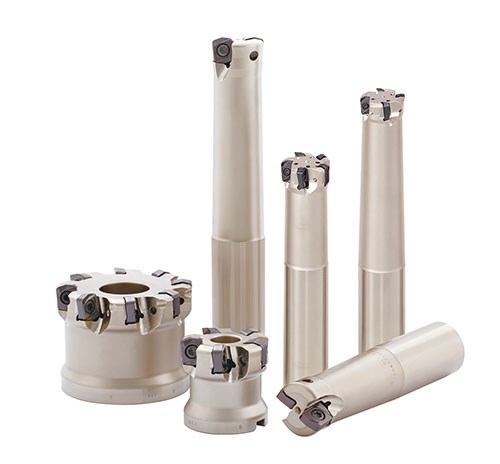The Cutter Affects Capacity
New machine tools allowed CTG to cut cycle time by 75 percent, but that wasn’t enough. Finding the right tool and process cut that cycle time further, giving the oil-industry manufacturer the capacity needed to support an important new product.
Share





CTG of Houston, Texas, has a straightforward strategy for dealing with cyclical business demand: The company remains always ready and willing to quickly ramp up its production.
Or, at least it remains willing. Being ready for a production increase is a different matter. Given how quickly and unexpectedly production might escalate for a given product, it is not always possible to be truly ready for the surge. The company therefore supports its customers with prototyping and short-run manufacturing work for the products those customers are developing, while it remains primed to respond—that is, ready to get ready—in case any of those products takes off.
Of course, most industrial sectors are cyclical, including automotive, aerospace and other industries machine shops routinely serve. However, CTG serves arguably the most volatile sector of all: the oil and gas industry. Manufacturing here is subject to frantic peaks and perilous crashes. As recently as late last year, high oil prices meant that oil-related manufacturing demand was as strong as it has ever been, for CTG and others. This year, the story has been much different. Because of the speed and severity of the changes, CTG has had to squarely confront the challenge of cyclicality, and the solution the company has found is this: Support new product development. The company makes it a priority to join with its customers not just in manufacturing but in the design work that comes before this. Not all designed products go to market, but some of them do, and they often go quickly. When that happens, CTG, since it already has a leg up on process knowledge, stands as the most obvious choice to take the product into full production.
The formula can even work too well. That was the case with the line of gate valves a customer recently introduced. CTG had been working with this customer to develop the product since 2012, but when oil prices first showed signs of softening (a change beneficial to this product—more on that later), the shop suddenly received an order for 400 units of the large machined stainless steel component at the heart of the device. In part because of the long cycle time for milling this part, the order seemed to require vastly more CNC machining capacity than CTG had available.
The company quickly moved to double this capacity, says George Parvaneh, machining production manager. It bought four new CNC machines, including two vertical machining centers capable of cutting the components faster than the shop’s existing verticals. But even this expansion wasn’t enough—the pace of manufacturing was still falling behind. The only solution would be to somehow further reduce cycle time. And the key to doing this proved to be the cutting tool.
The shop introduced a high-feed milling cutter to the process. To take this step, Mr. Parvaneh worked with Elliott Frazier, product manager with tool supplier Tungaloy. A high-feed mill is a tool not for removing more material with each pass, but instead for removing less material with each pass and using a high feed rate to take many more passes in a given span of time. The two men worked for one week to find just the right high-feed mill for the gate machining, along with the most productive parameters for applying this tool in the operation. When they were done, they had taken a cycle that was formerly 90 minutes on the new, more productive machining centers and reduced this to 45 minutes through the application of Tungaloy’s DoFeed high-feed tool.
Mr. Parvaneh says one of the lessons he took from this success is just how powerful the choice of cutting tool can be. The tool is not a commodity and it’s not a minor variable in the machining process. As CTG has observed, the cutting tool is a significant factor in determining just how much productive capacity the shop has available.
That discovery is even more fitting in light of the gate valve part, because increasing capacity of an existing resource is the very reason why the gate valve is important.
Refracking
Though CTG produces many oil-and-gas-industry parts and products, most of its business could be described this way: The company is all about the interface where oil and gas pipes and fittings come together. That has been its niche since the beginning.
Founded in the 1980s, the company (named Central Texas Gasket at that time) first began to succeed and grow when it implemented a then-novel method for making rubber gaskets. The gaskets were typically made using dies, but CTG applied CNC machines from the garment industry to cut out these gaskets using programmed cycles instead of hard tooling. The company later expanded into making Teflon spacers used between pipe flanges, parts made with CNC machine tools recognizable to metalworking shops. The company also got into metal machining, though this was primarily to make molds for the increasingly complex rubber components it was being asked to produce. Today, CTG’s strength is its ability to work with plastic, rubber and metal under one roof, efficiently producing assemblies made of all three. Thus, the gate component is actually a departure for the company, because the job involves production machining of metal exclusively.
Company CEO Cory Jackson describes the gate valve’s significance. The function of the product is simple, he says: It stops the flow of oil in a chosen section of an existing well. The importance is more subtle, having to do with economic and technological changes affecting oil production right now. The high oil prices of recent years encouraged new wells to be drilled, and CTG and other industry suppliers made parts and products to support this drilling. But now that oil prices have dropped, drilling new wells is not cost-effective. What has become cost-effective instead is improving existing wells. New hydraulic fracturing technology applied to an existing well can increase that well’s output at a fraction of the cost of drilling a new well. This “refracking” is justifiable given today’s oil prices, Mr. Jackson explains, and this operation is specifically where the new gate valve product is used. The gate stops the well temporarily so that refracking can be performed, opening the well to oil it wasn’t previously able to reach. Thus, this particular product is an enabler for one of the chief ways American oil producers can remain profitable within the market conditions today.
Amount of Machining
Mr. Parvaneh says the challenge of the machined component that is central to this gate is the amount of metal removal it requires. Though the component is roughly box-shaped, it typically includes a precise cylindrical feature at the part’s centerline that must be turned. The part therefore begins as a bar and begins its machining with this feature being cut on a lathe. This feature is then used as a dimensional reference for the cycle at the vertical machining center in which much of the bar’s material is milled away.
Prior to this part going into production, CTG’s capacity for machining metal was not oriented toward production, because most of the shop’s metal machining served to make mold tooling for the company’s own use. End-use machined metal parts were components of some subassembly that also included rubber or Teflon parts. That is, the metal parts were smaller and required much less machining than the gate components. When Mr. Parvaneh programmed the cycle to machine the gate part on the shop’s previous best metalcutting machining center, the shortest cycle time he was able to achieve was 6 hours per piece.
He went to management with this, because such a long cycle time meant that the shop was facing an emergency. Six hours per piece would be much too slow to meet the looming demand. He asked for newer, more rigid machines able to cut the 410 stainless at a higher metal removal rate, and this is exactly what the shop got. The company added two new Doosan CNC lathes for the end turning operation and, significantly, also added a new Doosan VMC and a preowned Sharp VMC that both offered the rigidity for heavier cutting in stainless. That rigidity delivered much of the cycle time savings the shop has attained—from 6 hours down to 90 minutes—but even this was not enough to keep pace.
Tungaloy’s Mr. Frazier says the shop was limited in its cycle-time reduction efforts because it was using that rigidity to cut deeper, to increase the metal removal rate by taking a heavier depth of cut. What about using that rigidity to cut faster instead? He suggested the DoFeed cutter, and he and Mr. Parvaneh experimented to see what parameters it could achieve.
The secret to the operation of a high-feed milling cutter is radial chip thinning, he says. The cutter uses an angle or a large-radius curve on the cutting insert to spread the chip and the cutting action along the insert’s profile, thus spreading out the load of this cutting as well. Thanks to this effect, much higher feed rates are possible with this tool than with more typical cutting edge designs. The tradeoff is the depth of cut; CTG uses the tool at an axial depth of 1 millimeter, because the chip thinning benefits disappear at any depth much greater. But in terms of the net cycle time to mill a given volume of material, the increase in feed rate more than makes up for the light depth. Previously, the shop milled the gate parts at 30 ipm. Now, it mills them at 390 ipm on the same machine. The VMC cycle for each gate is now just 45 minutes, including the finishing cuts taken with another Tungaloy tool.
Mr. Parvaneh says the faster feed rate—an increase by more than a factor of 10—dramatically changes the look of the machining cycle. He had to get used to this. During much of the experimentation to find the particular high-feed mill and set of parameters that worked best in this process, he was retraining himself to accept how rapidly it was now acceptable to see a machine feed the tool through this material.
Now, the high-feed milling cutter is the basis for CTG’s machining of the gate workpieces. The high-feed tool roughs away all the stock necessary to reduce the bar to a box, and it performs the helical interpolation to mill out the part’s large bore. Company machinist Leos Segura worked with Mr. Parvaneh to create macros for the new VMCs to allow the NC programs for different sizes and styles of the gate part to be quickly generated at the machine tool, further increasing efficiency by saving the need for a programming step.
With the cycle-time savings from the high-feed tool, CTG found the efficiency it needed to meet the gate-machining demand. It may have found something else as well, says Mr. Jackson—perhaps the next step forward in the development of the company’s services. Thanks to the gate machining, he points out, it is no longer true that most of the metalworking here is for the company’s own molds. Now, most of the metalworking by far is for making production parts. As a result of the success of the gate project, CNC metal machining is not a cost center for the company anymore, but instead has become a profit center.
Related Content
Toolpath Improves Chip Management for Swiss-Type Lathes
This simple change to a Swiss-type turning machine’s toolpath can dramatically improve its ability to manage chips.
Read MoreHow to Accelerate Robotic Deburring & Automated Material Removal
Pairing automation with air-driven motors that push cutting tool speeds up to 65,000 RPM with no duty cycle can dramatically improve throughput and improve finishing.
Read MoreCustom PCD Tools Extend Shop’s Tool Life Upward of Ten Times
Adopting PCD tooling has extended FT Precision’s tool life from days to months — and the test drill is still going strong.
Read MoreThe Future of High Feed Milling in Modern Manufacturing
Achieve higher metal removal rates and enhanced predictability with ISCAR’s advanced high-feed milling tools — optimized for today’s competitive global market.
Read MoreRead Next
Setting Up the Building Blocks for a Digital Factory
Woodward Inc. spent over a year developing an API to connect machines to its digital factory. Caron Engineering’s MiConnect has cut most of this process while also granting the shop greater access to machine information.
Read More5 Rules of Thumb for Buying CNC Machine Tools
Use these tips to carefully plan your machine tool purchases and to avoid regretting your decision later.
Read MoreRegistration Now Open for the Precision Machining Technology Show (PMTS) 2025
The precision machining industry’s premier event returns to Cleveland, OH, April 1-3.
Read More




































